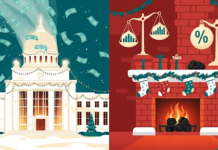As September rolls in, traders around the globe find themselves gripping their portfolios a little tighter. Historically a month that has sent shivers down the spines of even the most seasoned investors, September 2024 promises to be particularly perilous. With the Federal Reserve’s anticipated interest-rate cuts hanging in the balance, and a critical jobs report on the horizon, markets are poised for anything but smooth sailing.
The S&P 500 and Dow Jones Industrial Average have been notoriously unforgiving in September, often leaving investors licking their wounds. Bonds and gold aren’t faring much better, with both assets showing a troubling pattern of losses during this month over the past several years. As we dive into this edition of The Market Pulse, we’ll explore the reasons behind this September curse, the potential impact of the upcoming employment data, and how a few mega-cap tech stocks could tip the scales.
But it’s not all gloom and doom. In our This Week I Learned section, we’ll uncover the strategies that can help you outsmart the market’s seasonal quirks. And, for a bit of levity, don’t miss The Fun Corner, where we’ll share a humorous take on the market’s wild ride through September. Finally, our main article will look deep into the economic and political uncertainties that make this month so treacherous, and offer insights into how to navigate the storm.
This Week I Learned…
How September Became the Month Traders Fear
September’s reputation as a treacherous month for traders isn’t just based on folklore—it’s grounded in decades of data that show consistent market declines. This week, I learned that since 1950, the S&P 500 and the Dow Jones Industrial Average have both experienced their largest average percentage losses in September. Bonds, often seen as a safer bet, haven’t fared much better, with eight of the last ten Septembers ending in negative territory. Even gold, typically a haven in times of uncertainty, has dropped every September since 2017.
So, what’s behind this seasonal slump? One theory is that September is when traders return from their summer breaks and start reassessing their portfolios. This reassessment often leads to a sell-off in stocks and other assets as traders take profits and position themselves for the final quarter of the year. Another factor is the Federal Reserve’s actions—or inactions. This year, in particular, the market’s direction may hinge on the Fed’s next move, especially given the looming jobs report that could influence the magnitude and timing of interest-rate cuts.
For investors, understanding this pattern offers a valuable lesson: seasonal trends can have a significant impact on your portfolio. Whether you’re holding equities, bonds, or even gold, being aware of September’s pitfalls can help you make more informed decisions. Hedging your positions, reducing exposure to volatile assets, or even temporarily shifting to more defensive sectors like utilities or consumer staples could be wise moves during this unpredictable month.
This week, I learned that preparation and caution are key in September. Knowing the history helps, but having a strategy to weather the storm is what will truly make the difference.
The Fun Corner
September’s Market Madness: Why Did the Trader Cross the Road?
Why did the trader cross the road in September? To buy more puts and hedge his bets, of course!
September in the markets is like a game of dodgeball—except the balls are made of financial reports, surprise Fed announcements, and unexpected economic data. The month is notorious for its unpredictable swings, leaving traders scrambling to protect their portfolios. It’s no wonder some investors joke that September is the month when “even the bulls wear helmets.”
Consider this: since 1950, September has seen more market declines than any other month, leading traders to adopt some rather creative strategies for survival. Some go all-in on defensive stocks, others diversify into assets that typically resist volatility, and a few simply resort to crossing their fingers and hoping for the best.
But no matter how prepared they are, September always seems to throw a curveball—or ten. Whether it’s an unexpected jobs report, a last-minute Fed decision, or even the sudden reappearance of volatility, this month keeps everyone on their toes. So, here’s to surviving September: may your portfolio stay strong, your hedges stay intact, and your humor stay sharp—even if the markets don’t.
Why September is Every Trader’s Worst Nightmare
September has a reputation among traders that’s hard to shake—and for good reason. Historically, it’s been the most challenging month for the markets, consistently delivering more losses than gains. This year, 2024, looks no different, with several key factors poised to make September especially difficult to navigate.
First, let’s talk about the historical data. Since 1950, the S&P 500 and the Dow Jones Industrial Average have recorded their largest average percentage losses in September. Bonds and gold, usually seen as safer investments, haven’t provided much solace either, with bonds dropping in eight of the last ten Septembers and gold falling every September since 2017. The markets often struggle in this month as traders return from summer vacations and reassess their portfolios, leading to a wave of selling.
This year, however, there are additional layers of complexity. The Federal Reserve is expected to cut interest rates, but the timing and magnitude of these cuts remain uncertain. The upcoming US jobs report is crucial—it’s expected to offer insights into the health of the economy and could heavily influence the Fed’s decisions. Markets are already pricing in multiple rate cuts by the end of the year, but any surprises in the data could trigger sharp market reactions. With stocks trading near record highs and Treasuries enjoying a rare winning streak, both are vulnerable to any shocks.
Then, there’s the political climate. The first TV debate between Vice President Kamala Harris and former President Donald Trump is just around the corner, and it could sway the markets depending on the outcomes. The memory of the contested 2000 election lingers, raising concerns about what might happen if this election season turns similarly contentious.
In this uncertain environment, investors need to be prepared for heightened volatility. Hedging strategies, once considered expensive or unnecessary, are now looking like a bargain. Some analysts suggest that defensive sectors such as communication services, energy, and healthcare could offer better protection in this turbulent month.
The key takeaway? Caution is crucial in September. With so many variables in play—from economic data to political developments—the market could swing in any direction. As traders brace for what’s to come, the smartest move might be to hope for the best but prepare for the worst.
The Last Say
September’s Storm: Caution in a Month of Market Uncertainty
As we wrap up this edition of The Market Pulse, one thing is clear: September is no ordinary month for traders. With a history of poor market performance, compounded by the current economic and political uncertainties, caution is more than just advisable—it’s essential.
The Federal Reserve’s anticipated rate cuts are the main event on everyone’s radar, but the uncertainty surrounding these decisions could make markets jittery. The upcoming US jobs report is particularly crucial, as it may either reinforce or shatter current market expectations. If the data surprises to the downside, we could see sharp corrections in stocks, bonds, and even gold.
Adding to the mix is the political landscape. The upcoming debate between Vice President Kamala Harris and former President Donald Trump is another potential flashpoint for market volatility. Political uncertainty has historically contributed to market instability, and this year’s election cycle is unlikely to be an exception.
For investors, the best approach might be to adopt a defensive stance. Hedging has become more attractive, and sectors that typically perform well in downturns, like healthcare, energy, and communication services, could offer some shelter from the storm. While September’s reputation might tempt some to sit on the sidelines, others may see it as an opportunity to reposition and prepare for what lies ahead.In the end, September’s challenges remind us that market volatility is a natural part of investing. Whether it’s the Fed’s decisions, economic data, or political developments, staying informed and ready to act is key. As we move deeper into the month, remember that preparation and a steady hand are your best allies in navigating the unpredictable waters of September.


























